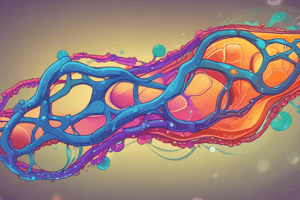Podcast
Questions and Answers
Where does the electron transport chain take place in the mitochondria?
Where does the electron transport chain take place in the mitochondria?
The electron transport chain occurs in the inner mitochondrial membrane, specifically on the cristae of the mitochondria.
What are the two main electron carriers that deliver electrons to the electron transport chain?
What are the two main electron carriers that deliver electrons to the electron transport chain?
NADH and FADH2
Which complex of the electron transport chain oxidizes NADH, and what molecules are involved in this process?
Which complex of the electron transport chain oxidizes NADH, and what molecules are involved in this process?
Complex I oxidizes NADH to NAD+, passing electrons to flavin mononucleotide (FMN) and then to coenzyme Q.
How does Complex III receive electrons, and what is the next step in the electron transport chain?
How does Complex III receive electrons, and what is the next step in the electron transport chain?
What is the final step of the electron transport chain, and what is the end product formed?
What is the final step of the electron transport chain, and what is the end product formed?
Which complexes of the electron transport chain contribute to the proton gradient across the inner mitochondrial membrane?
Which complexes of the electron transport chain contribute to the proton gradient across the inner mitochondrial membrane?
What is the overall function of the electron transport chain?
What is the overall function of the electron transport chain?
What is the final electron acceptor in the electron transport chain?
What is the final electron acceptor in the electron transport chain?
Which complex in the electron transport chain accepts electrons from cytochrome C?
Which complex in the electron transport chain accepts electrons from cytochrome C?
At which complexes in the electron transport chain are protons pumped out?
At which complexes in the electron transport chain are protons pumped out?
How does the proton concentration in the intermembrane space compare to that in the mitochondrial matrix?
How does the proton concentration in the intermembrane space compare to that in the mitochondrial matrix?
What are some of the components involved in passing electrons along the electron transport chain?
What are some of the components involved in passing electrons along the electron transport chain?
Flashcards are hidden until you start studying
Study Notes
- The electron transport chain occurs in the inner mitochondrial membrane, specifically on the cristae of the mitochondria.
- The outer membrane of the mitochondria is adjacent to the cytosol, followed by the intermembrane space, and then the inner mitochondrial membrane leading to the mitochondrial matrix.
- NADH and FADH2 generated from processes like glycolysis and the Krebs cycle deliver electrons to the electron transport chain.
- NADH is oxidized to NAD+ in the first complex (Complex I) of the chain, passing electrons to flavin mononucleotide (FMN) and then to coenzyme Q.
- FADH2 is oxidized to FAD in the second complex (Complex II), succinate dehydrogenase, passing electrons to FMN and then to coenzyme Q.
- Complex I pumps protons from the mitochondrial matrix to the intermembrane space, contributing to the proton gradient.
- Coenzyme Q passes electrons to Complex III (cytochrome Q-cytochrome Bc1 reductase), which transfers electrons to cytochrome C.
- Cytochrome C then passes electrons to the final complex, Complex IV or cytochrome oxidase, which transfers electrons to oxygen, forming water.
- During electron transfer, complexes I, III, and IV pump protons across the inner mitochondrial membrane, contributing to the proton motive force.
- The electron transport chain is a series of redox reactions involving multiple complexes and carriers to generate ATP through oxidative phosphorylation.- Electrons are picked up from +2 iron by half of an oxygen, combining with 2 protons to form water in the electron transport chain.
- Oxygen acts as the final electron acceptor in the electron transport chain, accepting electrons from previous components.
- Complex 4 in the electron transport chain accepts electrons from cytochrome C, leading to high energy levels that are then transferred to oxygen.
- Protons are pumped out at complex 1, complex 3, and complex 4 in the electron transport chain, helping establish a proton concentration gradient.
- The proton concentration in the intermembrane space can be significantly higher than in the mitochondrial matrix due to proton pumping.
- Various components like flavin mononucleotide, iron sulfur cluster proteins, coenzyme q, and cytochromes play crucial roles in passing electrons along the electron transport chain.
- The text mentions the importance of accounting for all NADHs in the Krebs cycle and transition step in the electron transport chain process.
Studying That Suits You
Use AI to generate personalized quizzes and flashcards to suit your learning preferences.



